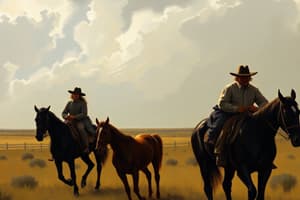Podcast
Questions and Answers
What was the main idea behind the concept of Manifest Destiny?
What was the main idea behind the concept of Manifest Destiny?
- To continue moving west until there was no more land in the United States (correct)
- To settle only in the already established states
- To expand the United States eastward
- To establish a separate nation for Native Americans
Which treaty marked the end of the Mexican-American War?
Which treaty marked the end of the Mexican-American War?
- The Treaty of Guadalupe (correct)
- Seward's Folly
- The Louisiana Purchase
- The Oregon Treaty
What was the main requirement for receiving land under the Homestead Act?
What was the main requirement for receiving land under the Homestead Act?
- Being a citizen of the United States for at least 10 years
- Paying a fee of $100
- Building a house with a minimum of 5 rooms
- Cultivating the land for at least 5 years (correct)
What was the significance of the Louisiana Purchase in 1803?
What was the significance of the Louisiana Purchase in 1803?
What was the main benefit of the Homestead Act for Americans?
What was the main benefit of the Homestead Act for Americans?
What was the significance of Seward's Folly in 1867?
What was the significance of Seward's Folly in 1867?
What were the three main challenges that homesteaders faced in order to be successful?
What were the three main challenges that homesteaders faced in order to be successful?
What was the main reason behind the construction of the Transcontinental Railroad?
What was the main reason behind the construction of the Transcontinental Railroad?
What was the primary function of the windmills invented by Hailday?
What was the primary function of the windmills invented by Hailday?
What was the main reason behind the Chinese Exclusion Act of 1882?
What was the main reason behind the Chinese Exclusion Act of 1882?
What was the primary advantage of the McCormick Reaper?
What was the primary advantage of the McCormick Reaper?
What was the main reason behind the migration of Chinese laborers to the West?
What was the main reason behind the migration of Chinese laborers to the West?
Flashcards are hidden until you start studying
Study Notes
The West and the American Indian Experience
- Manifest Destiny: The idea that the US was destined to expand its territory westward, with the goal of occupying all land in the United States.
- Louisiana Purchase (1803): Thomas Jefferson purchased the Louisiana Territory from France for approximately $15 million, doubling the size of the US.
- Treaty of Guadalupe Hidalgo (1845): Ended the Mexican-American War, resulting in the US gaining control of a significant amount of land, including present-day California, Nevada, Utah, Arizona, New Mexico, Texas, and parts of Colorado, Kansas, Oklahoma, and Wyoming.
- The Oregon Treaty (1846): Established the 49th parallel as the border between the US and British North America (now Canada).
Westward Expansion
- Seward's Folly (1867): Secretary of State William Seward purchased Alaska from Russia for $7.2 million, which was deemed a foolish decision at the time, but later proved valuable with the discovery of gold and oil.
- Annexation of Hawaii (1898): The US took possession of Hawaii, which became a US territory.
The Homestead Act
- The Homestead Act (1862): Allowed citizens to claim 160 acres of land for free, provided they lived on it, built a house, and cultivated the land for at least five years.
- Criteria for qualification: Applicants had to be at least 21 years old, build a house (at least 14ft by 12ft), and cultivate the land for at least five years.
- Benefits: Provided land to people who didn't have access to it, and helped to settle the West.
Challenges and Conflicts
- The Civil War (1861-1865): The Homestead Act was passed during this period.
- Challenges faced by homesteaders: drought, debt, and declining crop prices, which made it difficult for them to make a living.
- Exodusters: Former slaves who moved to the West in search of land and a better life.
Valuable Minerals and Resources
- Black Hills (Dakotas): Rich in gold and silver deposits.
- Colorado and Nevada: Rich in mineral deposits.
- Alaska: Rich in gold and oil.
The Transcontinental Railroad
- Completed in 1869: Connected the East and West coasts of the US.
- Benefits: Provided a direct route west, enabled dependable trade, created jobs, and facilitated the growth of mining and ranching.
- Land grants: The US government gave $170 million in land grants to railroad companies.
Inventions and Technology
- Place mining: A method of mining that uses a pan to separate gold and silver from rocks.
- Barbed wire: A type of metal fencing with spikes that helped to enclose ranches and farms.
- Mechanized farming: Led to the development of commercial farms and the growth of cash crops.
- Windmills: Used to pump water in areas where drought was frequent.
- McCormick Reaper: A machine that cut grain faster and more efficiently.
- Telegraph: Invented by Samuel Morse in 1837, and used to send reports during the Civil War.
Equality and Inequality on the Frontier
- Chinese laborers: Came to the US to work on the Transcontinental Railroad, fleeing poverty and war in China.
- Pacific Railroad Act (1862): Provided for the laborers' recruitment and working conditions.
- Chinese Exclusion Act (1882): Banned Chinese laborers from entering the US for 10 years, with exceptions for teachers, students, merchants, and diplomats.
- Act was renewed in 1888 and 1892, and repealed in 1943.
Studying That Suits You
Use AI to generate personalized quizzes and flashcards to suit your learning preferences.




